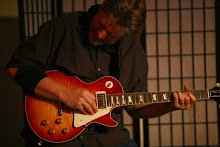Ken Bennett 1/11/2006 1:24 PM
The online article on pentatonic scales says: "... G7 is in the key center of C.... If you can play C major over G7, then you can also play, or superimpose, the three major pentatonics; G, C and D." The three major pentatonics in the key of C are C, F, and G, based on the I, IV, and V. Wouldn't the F# note in the D major pentatonic clash with the F natural in the G7 chord?
Don Mock 1/12/2006 5:52 PM
Ken, thanks for the question. Several people have caught the mistake in the text of the Pentatonic lesson. You are right, the three major pentatonics for a G7, key of C, is C, F and G pentatonics. Glad you were paying close attention. Also while I'm at it, let me clarify one more pentatonic for G7. On just about any chord, you can call upon the blues to add more sound to chords. For G7, the G minor (or Bb major) pentatonic is always available to use (musical style permitting). The scale sits outside traditional theory and on paper it looks like it should sound wrong with that minor third, but it's that very conflict between the major third in the chord and the minor third in the scale that gives that wonderful blues effect. And sure, there are lots of variations to the blues scale. G minor pent only has 5 notes but it's often referred to as a G "blues pentatonic." Add a Db to add more color and you have the common 6-note blues scale. Toss in the E (6th) and you have a 7 note version. And you can keep adding extra tones as long as you can make musical sense out of them. Thanks again for the post Ken, -Don Mock
Subscribe to:
Post Comments (Atom)

No comments:
Post a Comment